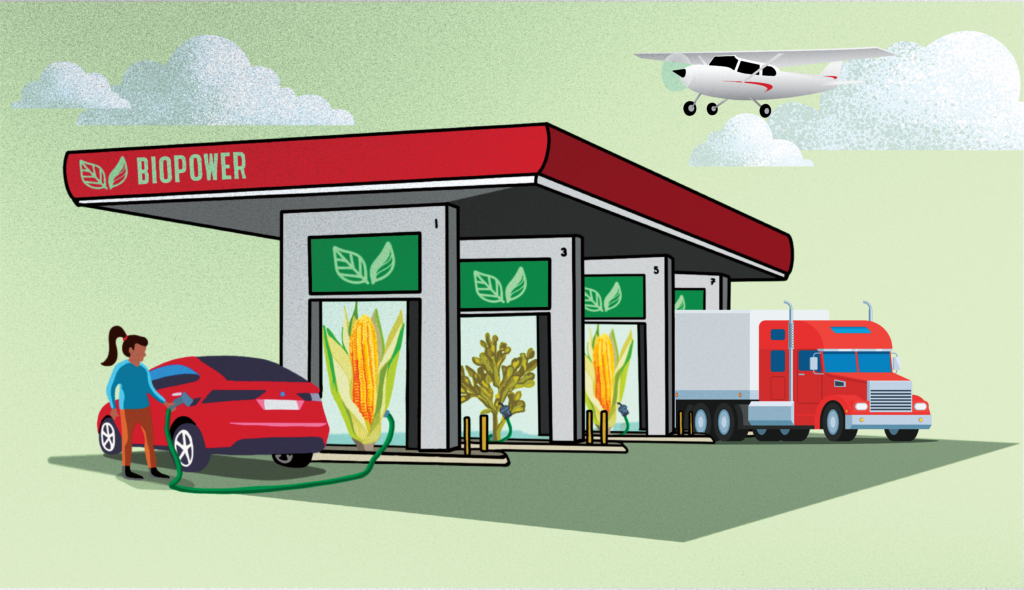Biofuels probably aren’t the first thing you think of when you’re putting gas in your car or getting on a flight. But for experts in renewable energy, biofuels are at the forefront of conversations about powering all transportation, from motorcycles to aircraft carriers. So, what are biofuels and how do they fit into a more sustainable future?
What are biofuels?
Biofuels are liquid, renewable energy sources created by converting the energy stored in organic matter like plants or agricultural waste—also known as biomass—into fuel.
As researchers discover new ways to engineer plants for biofuel production, the variety of biomasses continues to grow, including:
- corn
- soybeans
- switchgrass
- trees
- duckweed
- and algae
Creating biofuels is a complicated process, but the idea it has been around for a long time. Scientists have been working with renewable liquid fuels as far back as the 1800s when vegetable oil was used as fuel for cars with diesel engines. Now, we’re reimagining them as a source of energy for ships, planes and heavy machines.
Debra Mohnen, Distinguished Research Professor and University of Georgia Athletic Association Professor at the Complex Carbohydrate Research Center, has studied plant science for more than 35 years and biofuels for almost 20.
“The carbohydrates in plants are structurally complex,” says Mohnen. “There’s a reason trees can grow as high and tall as they can. There’s a reason plants can withstand wind and natural disasters. Those plants have evolved hundreds of millions of years to make complex carbohydrates in those cell walls. So now we want to take advantage of that complexity to turn them into renewable sources of fuel.”
Mohnen believes that investing in renewable energy is a necessary step in producing an alternative fuel source that won’t contribute to greenhouse gas emissions. She is working with other researchers to discover the best way to create biofuels.
How do you make biofuels?
Let’s break it down, literally.
Advanced biofuels, usually based on ethanol and other hydrocarbons, are created by breaking down a plant’s cellular structure. That breakdown can happen by:
- rapidly heating up biomass to turn it into “vapor, gas or char,”
- fermenting plant sugars with microorganisms like bacteria and yeast
- or processing biomass under high-pressure using hot water solvents.
These processes break down the original biomass to get to the useful stuff inside, like sugar. Of course, we’re not talking about the sugar you use to bake a cake or sweeten your coffee. The cellular structure of plants and many natural substances is made up of complex carbohydrates, which are essentially sugars like glucose linked together.
Breeanna Urbanowicz, a plant biochemist and research scientist at the UGA Complex Carbohydrate Research Center, says that there are many organisms that take advantage of modified forms of glucose. Shrimp shells, mushrooms, and the exoskeletons of insects and spiders are made of a molecule called chitin which uses interlocked glucose cells to create different and stronger properties.
“Your cotton t-shirt is made of glucose. The wood from your house. The paper you write on. Any natural fibers. It’s all made of sugars,” says Urbanowicz.
When you create biofuels, you take sugars that are linked together and break them down to into simple glucose again. This can be more easily made into biofuels and bioproducts.
To turn this into a feasible and cost-effective process, researchers are looking for spaces where they can grow these bioenergy crops and take advantage of large amounts of land that can’t be used for more profitable farming.
However, it’s not enough to have a lot of a certain plant. Researchers like Urbanowicz and her partners at the CCRC are also working on reprogramming plants to make them better sources of energy.
Reprogramming Plants
Mohnen’s research mainly focuses on pectin, a soluble fiber found in plants that guides cell structure and growth. Her research shows that there are ways to alter a plant’s cell structure to increase the amount of biomass generated from switchgrass, trees, and other plants. Researchers can also genetically alter plants to modify the cell wall so it’s easier to get the sugars out in the first place.
A research team at the U.S. Department of Energy has modified grass and rice plants to make specific sugars more accessible. Another study increased the oil content from plant leaves and seeds.
Scientists like Urbanowicz are learning to make subtle changes to the sugar patterns in plants to adjust the structure just enough without having negative effects on plants. This research may send us forward by lightyears in terms of our ability to process plants and convert them into fuels and products.
Mohnen says that scientists have progressed a lot in both increasing yield and improving quality in biomass, but there’s still a great deal of science to be done and data to be analyzed. It’s not as simple as just understanding plants or the process to convert them to fuel. You need biochemists, computational biologists, agronomists, genomics researchers.
You need all these people working together because different specialists work differently, and they see things from different perspectives. For example, scientists are now producing fuels from the non-carbohydrate portion of the plant biomass, lignin. Making the process both economical and efficient while using biomass grown in challenging environments will take the ingenuity of many scientists working together.
“We’re all looking to the future, and putting our perspectives together is the best way to envision renewable energy,” says Mohnen.
